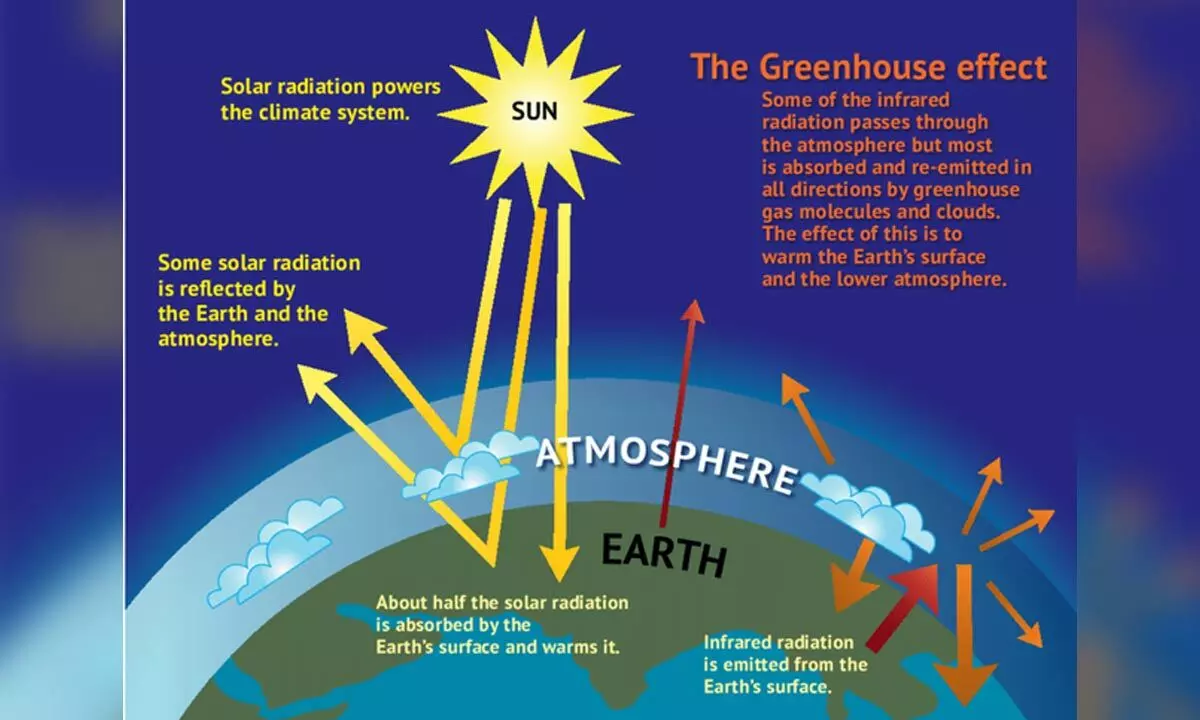Live
- Destiny Led Me to Music: Yamini Gowribhatla
- Officials told to closely monitor sand policy implementation
- Instagram Unveils Live Location Sharing and Enhanced DM Features
- Resolve public grievances on spot: Collector
- 26 gamblers held, Rs. 13.18 lakh seized
- Ajay Devgn’s Singham Again Soars Towards ₹240 Crore, While Bhool Bhulaiyaa 3 Dominates
- Assembly winter session begins today: Oppn to corner govt over mango kernel deaths
- Study shows how human memory works, gets stored
- Shadnagar: Increase Disability Pension To Rs 6,000
- Haryana Guv Dattatreya appreciates KDCCB
Just In
Atmospheric greenhouse gases ona steady climb, hit new records


The three most critical heat-trapping gases in Earth’s atmosphere again reached record levels last year, the U.S. National Oceanic and Atmospheric Administration (NOAA) said, underscoring the inadequacy of efforts to reduce greenhouse gas emissions amid the worsening climate emergency.
The three most critical heat-trapping gases in Earth’s atmosphere again reached record levels last year, the U.S. National Oceanic and Atmospheric Administration (NOAA) said, underscoring the inadequacy of efforts to reduce greenhouse gas emissions amid the worsening climate emergency. NOAA said the three most important human-caused greenhouse gases—carbon dioxide (CO2), methane, and nitrous oxide—”continued their steady climb during 2023.”
While the levels of these heat-trapping gases did not rise “quite as high as the record jumps observed in recent years,” the figures “were in line with the steep increases observed during the past decade.”
“We’re caught between a rock and a charred place.”
Global surface CO2 concentrations averaged 419.3 parts per million (ppm) last year, an increase of 2.8 ppm. It was the 12th straight year in which worldwide CO2 concentrations rose by more than 2 ppm.
Atmospheric methane—which while not as abundant as CO2 is up to 87 times more potent over a 20-year period—increased by 10 parts per billion (ppb) to 1,922.6 ppb, while nitrous oxide rose by 1 ppb to 336.7 ppb. “As these numbers show, we still have a lot of work to do to make meaningful progress in reducing the amount of greenhouse gases accumulating in the atmosphere,” Vanda Grubišić, director of NOAA’s Global Monitoring Laboratory, said in a statement.
According to NOAA, the amount of CO2 in the atmosphere today is comparable to where it was around 4.3 million years ago during the mid-Pliocene epoch, when sea level was about 75 feet higher than today, the average temperature was 7°F higher than in pre-industrial times, and large forests occupied areas of the Arctic that are now tundra.
About half of the CO2 emissions from fossil fuels to date have been absorbed at the Earth’s surface, divided roughly equally between oceans and land ecosystems, including grasslands and forests. The CO2 absorbed by the world’s oceans contributes to ocean acidification, which is causing a fundamental change in the chemistry of the ocean, with impacts to marine life and the people who depend on [it]. The oceans have also absorbed an estimated 90% of the excess heat trapped in the atmosphere by greenhouse gases. “Methane’s decadal spike should terrify us,” Rob Jackson, a Stanford University climate scientist who heads the Global Carbon Project—which tracks global emissions but wasn’t part of the NOAA effort—told NBC News. “Fossil fuel pollution is warming natural systems like wetlands and permafrost,” Jackson added. “Those ecosystems are releasing even more greenhouse gases as they heat up. We’re caught between a rock and a charred place.”
(Courtesy: https://www.commondreams.org/)

© 2024 Hyderabad Media House Limited/The Hans India. All rights reserved. Powered by hocalwire.com






